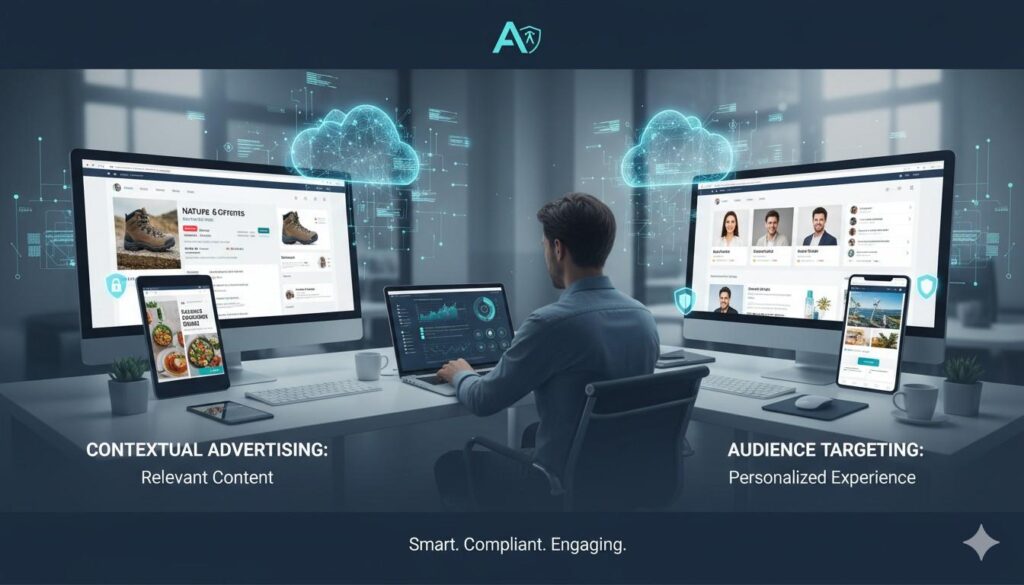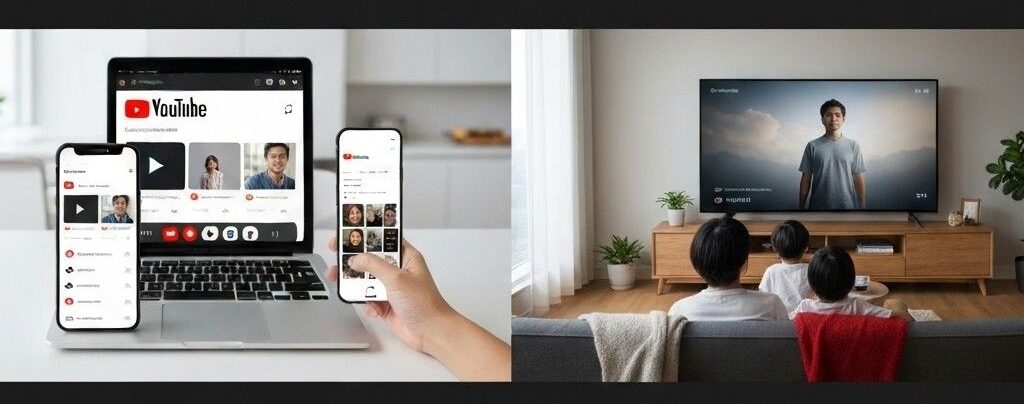YouTube has evolved from basic video uploads to a data-powered advertising engine. With over 2 billion monthly users, it’s central to brand and performance marketing.
At Brandcast 2025, YouTube put light on AI-powered tools like Peak Points and Shoppable YouTube CTV, redefining how brands show up during cultural moments. These innovations signal a shift toward smarter, more immersive ad placements across formats.
These changes mark a clear shift toward personalized ad experiences, designed to meet viewer behavior and intent head-on.
Here’s how YouTube’s ad formats have evolved and what brands should know to stay ahead.
Breakdown of YouTube’s Core Ad Formats
YouTube’s ad formats are designed to align with campaign goals, audience behavior, and platform inventory. Here’s a detailed look at the key formats:
Skippable In-Stream Ads (TrueView)
- Overview: Viewers watch the first 5 seconds before they can skip. AI optimizes thumbnails, hooks, and pacing in real-time for maximum engagement.
- Cost Model: Pay only when viewers watch 30 seconds or interact (e.g., click-through).
- Best For: Cost-efficient campaigns requiring a strong hook to capture attention.
- Creative Tip: Nail the first 5 seconds with compelling visuals or a direct question to combat skip culture.
Non-Skippable In-Stream Ads (15–20 Seconds)
- Overview: Viewers must watch the entire ad, ideal for high-impact storytelling, especially on Connected TV (CTV).
- AI Optimization: YouTube’s attention modeling places ads at optimal moments, like scene transitions, to maintain flow.
- Best For: Brand awareness campaigns needing emotional resonance.
- Creative Tip: Focus on pacing, emotion, and sound design to keep viewers engaged.
Bumper Ads (6 Seconds)
- Overview: Non-skippable, 6-second ads perfect for quick brand reinforcement.
- Best Use: Pair with longer formats to emphasize a single, memorable message.
- Creative Tip: Keep it concise, visually striking, and focused on one core idea.
Overlay Ads
- Overview: Subtle banner ads displayed on desktop videos (not CTV).
- Best For: Targeted campaigns needing low-intrusion visibility.
- Creative Tip: Use clear, clickable designs to drive supplemental engagement.
YouTube’s AI-driven delivery dynamically selects formats based on audience signals, inventory availability, and campaign objectives, ensuring smarter ad placements.
Viewer Behaviour Trends That Drive Format Optimization
Understanding viewer behavior is critical for optimizing ad formats. Here’s how trends shape YouTube’s advertising strategies:
Viewer Fatigue and Skipping Culture
- Stat: 76% of viewers skip ads when given the option (Google, 2025).
- Impact: Skippable ads need killer hooks within 5 seconds. Bumper ads thrive in this environment due to their brevity and skip-proof nature.
- Strategy: Prioritize fast-paced intros and compelling visuals to capture attention instantly.
CTV Viewership Surge
- Stat: YouTube CTV viewership grew 45% year-over-year in the UK (2025).
- Impact: Viewers treat YouTube on CTV like traditional TV, favoring non-skippable ads with natural pacing.
- Strategy: Craft story-driven ads with cinematic quality to blend seamlessly into the big-screen experience.
Data-Driven Engagement
- Shift: YouTube’s Demand Gen campaigns (replacing Video Action Campaigns) use predictive AI to anticipate user intent across YouTube, Gmail, and Discover.
- Impact: Every interaction (clicks, swipes, scrolls) informs a cohesive user journey, from video ads to product carousels.
- Strategy: Align creative with intent-driven targeting to boost conversions.
How Platform Data Enhances Ad Performance
YouTube’s data-driven approach optimizes ad delivery for engagement and brand recall. Key features include:
Ad Break Timing on CTV
- How It Works: Ads are placed at natural break points (e.g., scene changes, fade-outs) to minimize disruption.
- Benefit: Improves viewer retention and brand recall by aligning ads with content flow.
Sequenced Ad Delivery
- How It Works: Run ads in a predefined sequence (e.g., brand intro → testimonial → CTA) based on viewer engagement (views, impressions, skips).
- Benefit: Builds narrative momentum, guiding users from awareness to conversion.
- Strategy: Design story-driven sequences to reinforce messaging over time.
Performance Forecasting
- How It Works: YouTube’s forecasting tools analyze brand lift, retention data, and historical performance to recommend format mixes.
- Examples:
- Awareness: Heavy use of bumpers and non-skippables.
- Conversions: Skippables with strong CTAs.
- Benefit: Data-backed campaign planning tailored to specific goals.
Creative Strategies for a Multi-Format Environment
To succeed in YouTube’s dynamic ecosystem, brands must prioritize human-led creativity while leveraging data insights. Here’s how to optimize for each format:
Skippable In-Stream Ads
- Priority: Hook viewers in 5 seconds with fast visuals, punchy voiceovers, or direct questions.
- Example: Start with a bold statement like, “Why settle for less?” to grab attention.
Non-Skippable In-Stream Ads
- Priority: Focus on emotional storytelling, clear pacing, and intentional sound design.
- Example: Use a rising soundtrack and relatable narrative to maintain engagement on CTV.
Bumper Ads
- Priority: Deliver a condensed, brand-led message with striking visuals.
- Example: Highlight a single product feature or tagline in 6 seconds.
Ad Previewing and Testing
- Tools: Use Google Ads to preview ad rendering or platforms like Video Experiments and Lucid by Cint for audience feedback.
- Benefit: Ensures creative alignment with targeting and context before launch.
| Format | Creative Priority |
| Skippable In-Stream | Strong hook within 5 seconds |
| Non-Skippable In-Stream | Emotional narrative + pacing |
| Bumper Ads | Condensed, brand-led visuals |
| In-Feed Video Ads | Compelling thumbnails + metadata |
Brand Impact Through Personalized Ad Delivery
YouTube’s targeting capabilities ensure ads resonate with the right audience at the right time:
Intent-Driven Targeting
- How It Works: Leverages watch history, subscriptions, and search activity to align ads with user intent.
- Example: A tech review watcher sees ads for gadgets, not unrelated products.
Custom Affinity and In-Market Segments
- How It Works: Targets micro-audiences like “urban dog owners watching camping vlogs.”
- Benefit: Increases relevance and engagement by matching ads to specific personas.
Localized Creative at Scale
- How It Works: Customize visuals, pricing, or voiceovers for different regions within one campaign.
- Benefit: Enhances relevance without requiring multiple campaigns.
Contextual Topic Targeting
- How It Works: Places ads alongside thematically aligned content (e.g., skincare ads next to tutorials).
- Benefit: Boosts engagement and brand perception without relying on personal data.
Ethical Boundaries and Brand-Safe Execution
To maintain brand integrity in a data-driven world, consider these principles:
Avoiding Creative Homogenization
- Risk: Over-optimized ads can feel robotic or forgettable.
- Solution: Vary storytelling across formats to maintain brand uniqueness.
Balancing Performance and Brand Voice
- Risk: Prioritizing metrics over message quality can dilute brand identity.
- Solution: Ensure emotion, tone, and clarity align with brand values.
Human Oversight for Brand Safety
- How It Works: Platforms like Filament hand-review YouTube channels for contextual relevance and brand safety.
- Benefit: Ensures ads appear on safe, relevant channels, enhancing trust and impact.
Conclusion
YouTube’s ad formats are no longer just tools, they’re a creative canvas shaped by real-time data and viewer habits.
Whether your goal is awareness, recall, or conversions, success depends on more than just the message. It’s about where that message appears. Filament helps brands run brand safe YouTube campaigns using a Modern YouTube Strategy; Safe YouTube channels + contextual precision, paired with a human-verified approach to ad placement.
FAQ
-
How does YouTube choose between skippable and non-skippable ads?
YouTube uses campaign goals, audience signals, and inventory availability to select formats. Awareness campaigns favor non-skippables, while engagement campaigns lean toward skippables.
-
How does viewer behavior affect ad placement on YouTube CTV?
YouTube analyzes pauses, skips, and watch patterns to place ads at natural break points on CTV, reducing disruption and boosting engagement.
-
How do bumper ads fit into a larger campaign?
Bumper ads reinforce messages in 6 seconds, acting as reminders after longer ads to keep brands top of mind.
-
Can small brands use sequenced YouTube ads?
Yes, Video Action Campaigns enable small brands to create smart sequences that adapt based on viewer engagement, no large budget required.
-
How does YouTube keep audience targeting up to date?
YouTube continuously updates targeting using real-time data from watch history, searches, and engagements to deliver relevant ads.

I’m a results-driven marketing leader with 10+ years of experience building integrated media strategies that drive measurable ROI. As COO and co-founder of Filament, I shape the product roadmap, sales, and campaign performance. My background spans brand and performance media for top brands like Slack, Bumble, and Jenny Craig. A frequent speaker on measurement, I bring deep expertise in ad tech, data strategy, and media buying—always with a sharp focus on business impact. Previously I founded an attribution company, where I led campaign planning, attribution modeling, and executive-level reporting across TV, digital, and CRM channels.



